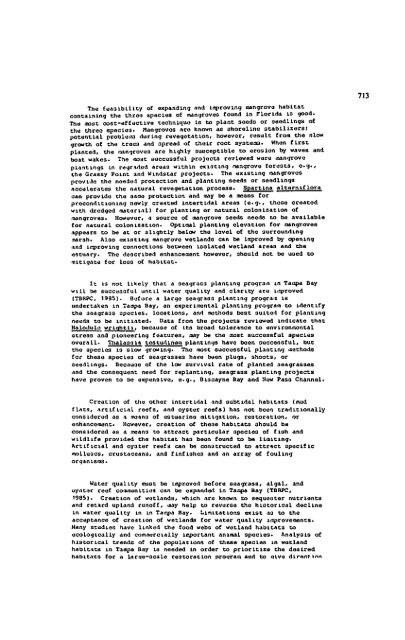Full document / COSOC-W-86-002 - the National Sea Grant Library
Full document / COSOC-W-86-002 - the National Sea Grant Library
Full document / COSOC-W-86-002 - the National Sea Grant Library
- TAGS
- nsgl.gso.uri.edu
You also want an ePaper? Increase the reach of your titles
YUMPU automatically turns print PDFs into web optimized ePapers that Google loves.
The feasibility of expanding and Improving mangrove habitat<br />
containing <strong>the</strong> three species of mangroves found in Florida to good-<br />
The most cost-effective technique Is to plant seeds or seedlings of<br />
<strong>the</strong> three species* Mangroves aro known as shoreline stabilizers;<br />
potential problems during revegetatlon, however, result from <strong>the</strong> slow<br />
growth of <strong>the</strong> trees and spread of <strong>the</strong>ir root systems* When first<br />
planned, <strong>the</strong> mangroves are highly susceptible to erosion by waves and<br />
boat wakes. The most successful projects reviewed were mangrove<br />
plantings in regraded areas within existing rangrove forests, e.g.,<br />
<strong>the</strong> Grassy Point and Windstar projects. The existing mangroves<br />
provide <strong>the</strong> needed protection and planting seeds or seedlings<br />
accelerates <strong>the</strong> natural revegetatlon process. Spartlna alternlflora<br />
can provide <strong>the</strong> same protection and may be a means for<br />
preconditioning newly created intertldal areas (e.g., those created<br />
with dredged material) for planting or natural colonization of<br />
mangroves. However, a source of mangrove seeds needs to be available<br />
for natural colonization. Optimal planting elevation for mangroves<br />
appears to be at or slightly below <strong>the</strong> level of <strong>the</strong> surrounding<br />
mar3h. Also existing mangrove wetlands can be improved by opening<br />
and irnproving connections between Isolated wetland areas and <strong>the</strong><br />
estuary. The described enhancement however, should not be used to<br />
mitigate for loos of habitat.<br />
It is not likely that a 3eagraas planting program in Tampa Bay<br />
will oe successful until water quality and clarity are improved<br />
(T3RPC, 1995). Before a large seagrass planting program la<br />
undertaken in Tacepa Bay, an experimental planting program to identify<br />
<strong>the</strong> seagrass species, locations, and methods best suited for planting<br />
needs to be initiated. Data from tho projects reviewed indicate that<br />
Halodule wrightli, because of its broad tolerance to environmental<br />
stress and pioneering features, may be <strong>the</strong> most successful species<br />
overall. Thalasaia testudlnum plantings have been successful, but<br />
<strong>the</strong> species is slow growing. The most successful planting methods<br />
for <strong>the</strong>se species of seagrasses have been plugs, shoots, or<br />
seedlings* Because of <strong>the</strong> low survival rate of planted seagrasses<br />
and <strong>the</strong> consequent need for replanting, seagrass planting projects<br />
have proven to be expensive, e.g., Biscayne Bay and New Pass Channel.<br />
Creation of tho o<strong>the</strong>r intertldal and subtidai habitats (mud<br />
flats, artificial reefs, and oyster reefs) has not been traditionally<br />
considered as a means of estuarine mitigation, restoration, or<br />
enhancement* However, creation of <strong>the</strong>oe habitats should be<br />
considered as a means to attract particular 3pecles of fish and<br />
wildlife provided tho habitat has been found to be limiting.<br />
Artificial and oyster reefs can be constructed to attract specific<br />
molluscs, crustaceans, and finfishes and an array of fouling<br />
organisms.<br />
Water quality must be improved before seagrass, algal, and<br />
oyater reef communities can be expanded in Tampa Bay (TBRPC,<br />
1985). Creation of wetlands, which are known to sequester nutrients<br />
and retard upland runoff, may help to reverse <strong>the</strong> historical decline<br />
in water quality in in Tatrpa Bay. Limitations exist as to <strong>the</strong><br />
acceptance of creation of wetlands for water quality improvements.<br />
Many studies have linked <strong>the</strong> food webs of wetland habitats to<br />
ecoLogically and commercially important animal speclos. Analysis of<br />
historical trends of <strong>the</strong> populations of <strong>the</strong>se species in wetland<br />
habitats in Tampa Bay is needed in order to prioritise <strong>the</strong> desired<br />
habitats for a large-scale restoration program and to olva dlreoi*..tin<br />
713















